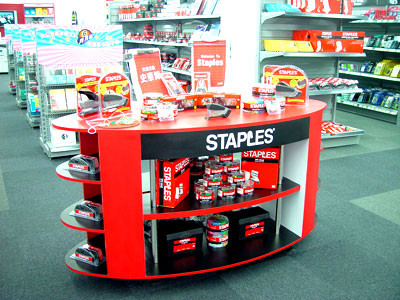(单词翻译:单击)
In 1986, Tom Stemberg opened the first Staples superstore in Massachusetts. Stationery retailers have not stood still since. By 1990, Mr Stemberg’s disruptive bright idea had spawned dozens of lookalike office supply warehouses. “When people asked how it felt to be the father of the industry, my answer was ‘I wish I’d used a condom’,” Mr Stemberg tells me.
1986年,汤姆•施滕贝格(Tom Stemberg)在美国马萨诸塞州开了第一家史泰博(Staples)大型超市。文具零售商自那以来就没有了安稳日子。到1990年,从施滕贝格那具有颠覆性的奇思妙想中,已诞生了几十家相互酷似的办公用品仓储超市。“当人们问我对成为该行业之父有何感想时,我的回答是‘我多希望自己当时戴了安全套’,”施滕贝格对我说。

Consolidation followed, but in 1997, regulators blocked Staples’ bid for Office Depot. Last week, Office Depot again agreed to be bought by Staples, for $6.3bn. Antitrust approval is not a given, but what the US Federal Trade Commission deemed a potentially dominant position 18 years ago now looks more like a defensive necessity.
随后兴起了整合潮,但在1997年,监管机构拒不批准史泰博收购欧迪办公(Office Depot)。今年2月初,欧迪办公再次同意以63亿美元出售给史泰博。这项收购还不一定能获得反垄断机构的批准,但美国联邦贸易委员会(FTC)在18年前认为可能形成市场支配地位的这项收购,如今看来更像是一次迫在眉睫的防御之举。
So is that it for the category-killing, big-box retail trend of which Staples was part? Almost certainly not. The industry can still teach others a few lessons about strategy — and they are not all gloomy.
那么,对于品类杀手型超大卖场零售趋势(史泰博便是该趋势的一部分)而言,大势已去吗?几乎可以肯定地说,并非这样。在战略方面,该行业仍有一些东西可以教给其他人——这些教训并不都是消极的。
• Do not count on staying dominant. As Rita Gunther McGrath noted in her book The End of Competitive Advantage , with few exceptions, “stability, not change, is the state that is most dangerous in highly dynamic competitive environments”.
• 不要过分依赖市场支配地位。正如丽塔•冈瑟•麦格拉思(Rita Gunther McGrath)在其著作《竞争优势的终结》(The End of Competitive Advantage)中所述,除了极少的例外情况,“在高度动态化、竞争性的环境里,最危险的状态不是变化,而是稳定”。
Mr Stemberg and others fired the staple-gun that launched a new era, in which the half-life of dominant companies has shortened dramatically. A strategy that had served stationers and their customers well for centuries withered in 1986, but Staples’ approach barely survived 10 years before it too was under attack.
施滕贝格等人按下了钉枪,启动了一个新时代,在这个新时代,占市场支配地位的公司的“半衰期”大幅缩短了。为文具商及其客户成功服务了几个世纪的战略,在1986年失效了,但史泰博的经营方式在遇到挑战前仅勉强维持了10年。
• Stay competitive on price. Staples and others launched at a point when the cost of office machines was starting to fall. Sales of computer and printer equipment provided a solid foundation for growth, underpinning the discounts on pens, paper and notepads and other bulk supplies. It soon became clear, however, that . . .
• 保持价格竞争力。在史泰博等公司创立之时,办公设备的价格开始下降。计算机和打印机设备的销售为这些公司的增长奠定了坚实基础,对钢笔、纸张和便条簿等大宗物品的降价销售提供了支撑。不过,不久后显而易见的是……
• . . . in retail, your biggest competitor is the internet. Two years ago, when it approved a merger between Office Depot and OfficeMax, number three in the market, the FTC conceded that customers now “look beyond” superstores. In fact, if the commissioners had glanced up in 1997, they would have seen Amazon, which went public that year, on the horizon. At the time, Staples rightly argued the internet would increase price transparency. But it was still early days: the commission concentrated instead on the deal’s impact on the fraction of the market served by superstores.
• ……在零售业,你最大的竞争对手是互联网。两年前,当批准欧迪办公与OfficeMax(市场中的老三)的合并案时,美国联邦贸易委员会承认,顾客目前“不仅仅关注”大型超市。事实上,如果委员们在1997年抬头一看,他们应该能看到当年上市的亚马逊(Amazon)正崭露头角。当时,史泰博正确地指出,互联网将提高价格透明度。但那时互联网仍处于发展早期,联邦贸易委员会关注的是该笔收购对大型超市所服务的那部分市场的影响。
• But do not ignore your offline competitors. Big suppliers proved susceptible to death by a thousand paper-cuts on main street and in malls, as the likes of Costco, the retail club, Target and Walmart’s supermarkets and Walgreens’ pharmacies extended their stationery departments.
• 但也不要忽视你的线下竞争对手。零售俱乐部好市多(Costco)、超市Target和沃尔玛(Walmart)、以及药店Walgreens等等都扩展了文具部,被街边和商场中的竞争对手用纸划伤上千次,大型文具零售商也是很容易阵亡的。
• Dominance opens a (small) space for specialists. Tablets and smartphones may have cut bulk orders of printer ink and paper, and offered consumers alternatives to pad, pen and pencil. But specialist stationers are starting to fill a niche for retail customers with bespoke, high-end or quirky ranges of the same paper-clips, ballpoint pens and notebooks sold by the discounters. James Ward, author of an offbeat history, Adventures in Stationery , says devices “change the meaning of stationery” as the lightbulb changed the meaning of candlelight: “The flaws in a technology, once it gets replaced, become its charm.”
• 大型文具零售商的市场支配地位给专业厂商留出了(很小的)空间。平板电脑和智能手机可能已夺走了打印机油墨和打印纸的许多订单,并为顾客提供了便条薄、钢笔和铅笔之外的选择。但专业文具商开始填补一个小众市场,即针对折扣商店销售的回形针、圆珠笔和笔记本,为零售顾客提供定制的、高端的、或奇特版产品。讲述一段不寻常历史的《文具历险记》(Adventures in Stationery)的作者詹姆斯•沃德(James Ward)表示,各种新设备“改变了文具的含义”,正像电灯泡改变了烛光的含义一样:“某一技术的缺陷,在该技术被取代之后,反而成了它的魅力。”
• The category killer is not dead. Staples is closing stores and will go on doing so. But the office supply group, which would have more than 4,000 outlets if this final consolidation goes ahead, also operates a vast ecommerce site and has large contracts with corporate and government clients (the likely focus of any FTC attention).
• 品类杀手没有死。史泰博正在关闭一些门店,并将继续这么做。但这家办公用品集团——如果此次最终合并成功的话,将拥有逾4000家分店——还经营着一个大型电商网站,与企业及政府客户签有大笔合同(可能成为联邦贸易委员会关注的焦点)。
• Size still counts. Mr Stemberg, now a partner with the Highland Consumer Fund, is a director of pet product retailer Petsmart (1,400 stores), which is about to be taken over by private equity, and CarMax, the chain of 140 used-car superstores. He points to Total Wine & More, with over 100 wine hypermarkets across the US, as another example of the category-killer model still hard at work.
• 规模仍然重要。施滕贝格目前是Highland Consumer Fund的合伙人,也是即将被私人股本公司收购的宠物产品零售商Petsmart(拥有1400家门店)、以及拥有140家二手汽车大型超市的连锁企业CarMax的董事。他以在全美拥有逾100家葡萄酒特大型超级市场的Total Wine & More为例,证明品类杀手模式仍在努力运作。
In its combination of frenzied investment and copycat ideas, US retail in the late 1980s looks a bit like the dotcoms a decade later. But, as Staples’ founder says, “a lot of great companies came out of that era”. Some survived many years. A few are still going. Before consigning their strategies to a $6.79 Staples trash can, remember that few entrepreneurs in any industry — let alone veterans of the dotcom bubble — will be able to make that boast.
在狂热投资和思路抄袭的综合作用下,1980年代后期的美国零售业有点儿像十年之后的互联网热潮。但正如史泰博的创始人所说,“很多伟大的公司诞生于那个年代”。有些公司持续存活了很多年。有几家仍在经营中。在把这些公司的战略扔进6.79美元的史泰博垃圾桶之前,请记住,任何行业中都没几位企业家敢于夸下这个海口,互联网泡沫中的老油条就更不用提了。


